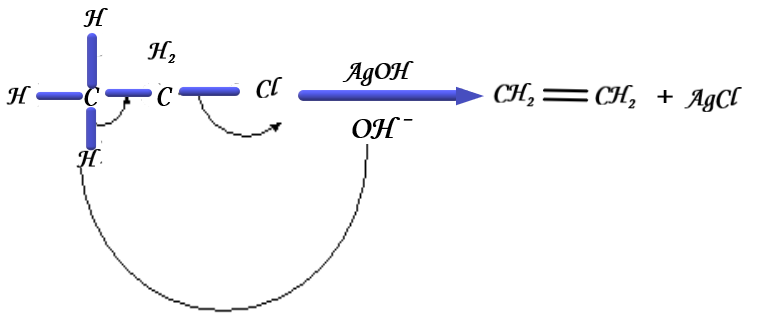
Which of the following products is obtained, when chloroethane reacts with silver oxide suspended in boiling water?
(A) \[C{H_3}C{H_2}C{H_2}C{H_3}\]
(B) \[C{H_3}C{H_3}\]
(C) \[C{H_3}C{H_2}OH\]
(D) \[C{H_3}C{H_2}OC{H_2}C{H_3}\]
Answer
219.6k+ views
Hint: In the given reaction, the leaving group is being eliminated to produce an unsaturated hydrocarbon as the main product and a salt as a side product. The base in this situation is silver oxide.
Complete Step by Step Solution:
The answer to the question is that silver oxide suspended in boiling water reacts with chloroethane.
As is well known, silver hydroxide is produced when silver oxide combines with water.
\[A{g_2}O + {H_2}O \to 2AgOH\]
The reaction of chloroethane with a silver oxide is shown below:
\[{C_2}{H_5}Cl{\text{ }} + {\text{ }}AgOH \to \;{C_2}{H_5}OH\; + {\text{ }}AgCl\]
In this process, silver oxide and chloroethane combine to generate ethanol with a double bond and silver chloride.
The following diagram illustrates the mechanism of chloroethane with a silver hydroxide:

In this reaction, the alcoholic \[AgOH\] acts as the base which will attack the hydrogen atom to form water. After the removal of hydrogen, the bond will shift to form an ethene and remove the chlorine. The chlorine acts as a nucleophile which will attack the positive silver ion to form silver chloride.
Anhydrous silver oxide is dissolved in ethanol to produce alcoholic silver hydroxide. It is utilised in water-sensitive elimination processes. An illustration of an elimination reaction is this one. A molecule with a saturated carbon (single bond) can become an unsaturated carbon through the elimination reaction (double bond).
In this reaction the leaving group from the reactant, which is removed to form an unsaturated carbon compound.
Therefore, the correct answer is: (C) \[C{H_3}C{H_2}OH\].
Note: Dehydrohalogenation is another name for this process. Make that the silver oxide being utilised in the reaction is of the alcoholic variety. When chloroethane and aqueous silver oxide combine, the major product that results after the silver chloride is removed is alcohol.
Complete Step by Step Solution:
The answer to the question is that silver oxide suspended in boiling water reacts with chloroethane.
As is well known, silver hydroxide is produced when silver oxide combines with water.
\[A{g_2}O + {H_2}O \to 2AgOH\]
The reaction of chloroethane with a silver oxide is shown below:
\[{C_2}{H_5}Cl{\text{ }} + {\text{ }}AgOH \to \;{C_2}{H_5}OH\; + {\text{ }}AgCl\]
In this process, silver oxide and chloroethane combine to generate ethanol with a double bond and silver chloride.
The following diagram illustrates the mechanism of chloroethane with a silver hydroxide:

In this reaction, the alcoholic \[AgOH\] acts as the base which will attack the hydrogen atom to form water. After the removal of hydrogen, the bond will shift to form an ethene and remove the chlorine. The chlorine acts as a nucleophile which will attack the positive silver ion to form silver chloride.
Anhydrous silver oxide is dissolved in ethanol to produce alcoholic silver hydroxide. It is utilised in water-sensitive elimination processes. An illustration of an elimination reaction is this one. A molecule with a saturated carbon (single bond) can become an unsaturated carbon through the elimination reaction (double bond).
In this reaction the leaving group from the reactant, which is removed to form an unsaturated carbon compound.
Therefore, the correct answer is: (C) \[C{H_3}C{H_2}OH\].
Note: Dehydrohalogenation is another name for this process. Make that the silver oxide being utilised in the reaction is of the alcoholic variety. When chloroethane and aqueous silver oxide combine, the major product that results after the silver chloride is removed is alcohol.
Recently Updated Pages
Chemical Equation - Important Concepts and Tips for JEE

JEE Main 2022 (July 29th Shift 1) Chemistry Question Paper with Answer Key

Conduction Explained: Definition, Examples & Science for Students

Analytical Method of Vector Addition Explained Simply

Atomic Size - Important Concepts and Tips for JEE

JEE Main 2022 (June 29th Shift 1) Maths Question Paper with Answer Key

Trending doubts
JEE Main 2026: Application Form Open, Exam Dates, Syllabus, Eligibility & Question Papers

Derivation of Equation of Trajectory Explained for Students

Hybridisation in Chemistry – Concept, Types & Applications

Understanding the Angle of Deviation in a Prism

Understanding Collisions: Types and Examples for Students

Understanding Atomic Structure for Beginners

Other Pages
NCERT Solutions For Class 11 Chemistry Chapter 7 Redox Reaction

JEE Advanced Marks vs Ranks 2025: Understanding Category-wise Qualifying Marks and Previous Year Cut-offs

Thermodynamics Class 11 Chemistry Chapter 5 CBSE Notes - 2025-26

NCERT Solutions ForClass 11 Chemistry Chapter Chapter 5 Thermodynamics

Equilibrium Class 11 Chemistry Chapter 6 CBSE Notes - 2025-26

Organic Chemistry Some Basic Principles And Techniques Class 11 Chemistry Chapter 8 CBSE Notes - 2025-26




